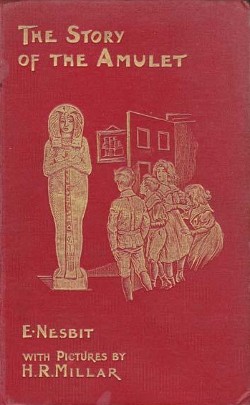The Story of the Amulet facts for kids

First edition
|
|
| Author | Edith Nesbit |
|---|---|
| Illustrator | H. R. Millar |
| Country | United Kingdom |
| Language | English |
| Series | Psammead Trilogy |
| Genre | Fantasy, Children's Novel |
| Publisher | T. Fisher Unwin |
|
Publication date
|
1906 |
| Media type | Print (hardback & paperback) |
| Preceded by | The Phoenix and the Carpet |
The Story of the Amulet is an exciting adventure novel for children. It was written in 1906 by the famous English author Edith Nesbit. This book is the last part of a magical series. The series also includes Five Children and It and The Phoenix and the Carpet. In this story, the children meet their old friend, the magical creature called the Psammead, again. This time, the Psammead helps them understand a special Egyptian Amulet. The Amulet can take them on amazing journeys through time! The author Gore Vidal called it "a story of considerable beauty."
Contents
A Magical Journey Through Time
At the start of the book, the four children – Robert, Anthea, Cyril, and Jane – are living in London. Their dad is away reporting on a war in Manchuria. Their mom is in Madeira getting better from an illness. Their baby brother, the Lamb, is with her. The children are staying with an old Nurse, Mrs. Green. She runs a boarding house in central London.
Meeting New Friends
The only other person staying at the house is a kind, smart man. He is an Egyptologist, someone who studies ancient Egypt. His room is full of old Egyptian treasures. The children quickly become friends with him. They even start calling him Jimmy.
Nurse Green's house is in Fitzrovia, a part of London near the British Museum. Nesbit describes this area as having cool shops. These shops sell old books and unusual items. In one of these shops, the children find the Psammead. This magical creature was caught by a trapper. The trapper did not know it was special. The Psammead was scared because it could not grant wishes for itself. It could only grant wishes for others. The children trick the shopkeeper into selling them the "mangy old monkey." Then, they set their old friend free!
The Mysterious Amulet
The Psammead guides the children to buy an ancient amulet. This amulet looks like an Egyptian Tyet symbol. A real amulet like it can be seen in the British Museum today. The children hope this amulet can bring their parents and baby brother home safely. This is their biggest wish.
But there's a problem! This amulet is only half of a complete one. By itself, it cannot grant their wish. However, it can open a portal. This portal lets them travel through time to find the missing half.
Adventures Through Time
The Amulet takes the children and the Psammead to different times and places. They visit places where the Amulet has been before. They hope to find its other half. They travel to ancient Babylon and Egypt. They also visit the Phoenician city of Tyre. They even go on a ship to the "Tin Islands" (which was ancient Cornwall). They also see Atlantis right before it sinks!
In one adventure, they meet Julius Caesar. This happens on the shores of Gaul. Caesar is thinking about not invading Britain. But Jane, with her innocent chatter about how great England is, convinces him. Her words make Caesar decide to invade after all!
During their time travels, the children can magically understand and speak the local languages. Nesbit mentions this in the story. Later, they even bring Jimmy, the "Learned Gentleman," along on some trips. But Jimmy does not have the same magic gift. He can only understand old languages like Latin because he studied them.
A Glimpse of the Future
In one chapter, the children travel to the future. They visit a British utopia. This is a perfect place where everyone lives happily. In this future, H. G. Wells is seen as a great leader. Both Wells and Nesbit were part of a political group called the Fabian Society. This future trip is different from their other adventures. The other trips show detailed past civilizations. But this trip shows Nesbit's dream of a perfect world.
This part of the story focuses on how children's school life would be different. Economic changes are only briefly mentioned. It also talks about a big problem in Nesbit's time: many children were getting hurt or killed each year. Laws like the Children Act 1908 later helped with this issue.
How This Story Inspired Others
The Story of the Amulet inspired parts of C. S. Lewis's famous Narnia series. This is especially true for The Horse and His Boy and The Magician's Nephew. For example, the Calormene god Tash is very similar to a god called Nisroch in Nesbit's book. The name of the Calormene king, the Tisroc, might also come from Nisroch. Lewis's Tisroc, like Nesbit's King of Babylon, must always have "may he live forever" said after his name. Also, the Jadis, Queen of Charn, appearing in London in The Magician's Nephew is much like the Queen of Babylon's trip to London in Nesbit's story.
British poet Basil Bunting also mentioned Nesbit's book. In his poem "Villon," he said he got an idea from The Story of the Amulet. He also called Nesbit's work the “pleasantest reading of my childhood.”


